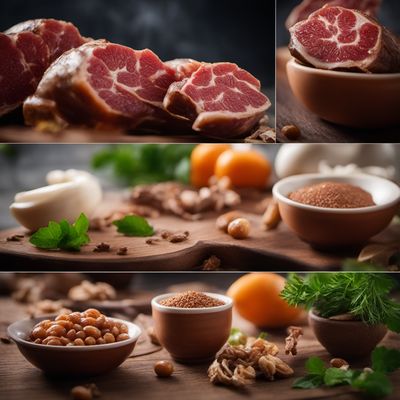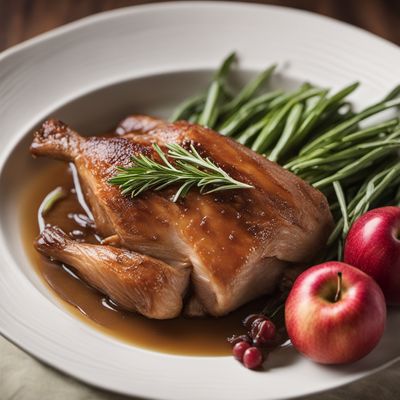
Ingredient
Duck carcase
The Essence of Duck: Unveiling the Secrets of Duck Carcase
Duck carcase refers to the skeletal structure of a duck after the removal of the meat. It is typically composed of bones, cartilage, and connective tissue, which contribute to its gelatinous texture when cooked. The carcase is known for its deep, savory flavor, which intensifies during the cooking process. Its appearance is characterized by a pale color and a complex network of bones, providing a visually appealing element to dishes.
Origins and history
Duck carcase has a long history in culinary traditions, particularly in Asian and European cuisines. Ducks have been domesticated for thousands of years, with evidence of their consumption dating back to ancient China and Egypt. In Chinese cuisine, duck carcase is often used to make nourishing soups, while in French cuisine, it forms the foundation of classic sauces like demi-glace. Its cultural significance and historical usage make it an integral part of many traditional dishes.
Nutritional information
Duck carcase is a good source of collagen, protein, and essential minerals such as calcium and phosphorus. It is relatively high in calories, with approximately 150 calories per 100 grams.
Allergens
Duck carcase may contain allergens such as poultry and bird-related allergens. Individuals with poultry allergies should exercise caution when consuming dishes made with duck carcase.
How to select
When selecting duck carcase, look for pieces that are fresh and have a firm texture. Avoid carcases with any signs of discoloration, foul odor, or excessive bruising. Additionally, choose carcases that have a good ratio of meat to bone, as this will contribute to a more flavorful stock or soup.
Storage recommendations
To maintain the freshness and quality of duck carcase, it is best to store it in the refrigerator at a temperature below 40°F (4°C). It is recommended to use the carcase within 2-3 days of purchase or freeze it for longer-term storage. If freezing, ensure it is properly wrapped to prevent freezer burn.
How to produce
Amateur cooks can produce duck carcase by purchasing a whole duck and carefully removing the meat, leaving behind the bones and connective tissue. Alternatively, one can ask a butcher to provide a duck carcase.
Preparation tips
To prepare duck carcase, it is commonly used to make a flavorful stock or broth. Start by roasting the carcase in the oven until golden brown, then simmer it with aromatic vegetables, herbs, and water for several hours to extract the rich flavors. Skimming off any impurities that rise to the surface during cooking will result in a cleaner and clearer stock. Additionally, the carcase can be used to make a gelatinous aspic or added to stews for added depth of flavor.
Culinary uses
Duck carcase is primarily used to make stocks, broths, and sauces. It serves as a flavorful base for soups, risottos, and gravies, adding depth and complexity to the final dish. Additionally, the carcase can be used to infuse flavor into rice or grains, enhancing their taste and aroma.
Availability
Duck carcase is commonly available in regions where duck is consumed, such as China, France, and the United States. It can be found in specialty butcher shops, Asian markets, and some supermarkets.
More ingredients from this category » Browse all

Wild boar carcase
Untamed Bounty: Wild Boar

Sheep carcase
The Art of Lamb: Exploring the Versatility of Sheep Carcass

Chicken carcase
The Foundation of Flavor: Unleashing the Potential of Chicken Carcase

Bovine carcase
The Foundation of Flavor

Turkey carcase
The Versatile Turkey Carcase

Pig carcase
Pig Carcase: A Versatile Ingredient

Rabbit carcase
The Art of Rabbit: Unlocking the Culinary Potential of Rabbit Carcass

Asses-mules-hinnies carcase
The Forgotten Meat

Horse carcase
The Noble Beast: Horse Meat

Goose carcase
The Flavorful Foundation

Ratites carcase
The Exotic Delicacy: Ratites Carcase Unveiled

Deer carcase
Venison: The Wild Delicacy
Recipes using Duck carcase » Browse all

Roasted Duck Stuffed with Millet Porridge
African-inspired Roasted Duck with Nutty Millet Stuffing

Xinjiang-style Duck Rice
Spiced Duck Delight: Xinjiang-inspired Rice Dish

Crispy Duck with Five-Spice Glaze
Imperial Five-Spice Glazed Duck: A Regal Delight

Roasted Duck with Honey-Glazed Apples
Slovenian Delight: Roasted Duck with Sweet Honey-Glazed Apples

Roman-style Duck Rice
Savory Roman Duck Rice Delight

Argentinian-style Pato no Tucupi
Tucupi Duck Delight: A Taste of Argentina

Indian-style Duck Curry with Bamboo Shoots and Spices
Spicy and Fragrant Duck Curry with Bamboo Shoots - A Taste of India

Roast Duck with Apples
Northern Irish Twist: Roasted Duck with Cider-Glazed Apples

Padang-style Spiced Duck
Savory Spiced Duck with a Padang Twist

Chifa-style Ginger Duck
Peruvian Fusion: Ginger-infused Chifa Duck

Curry Duck with Caribbean Flavors
Savory Caribbean Delight: Curry Duck with a Twist

Roasted Duck with Cherry Sauce
Succulent Duck Delight with Tangy Cherry Sauce